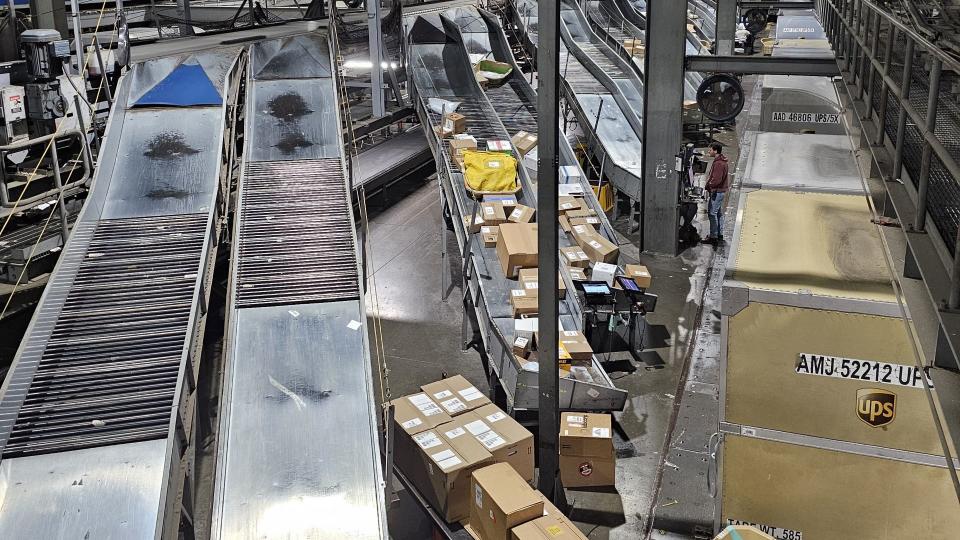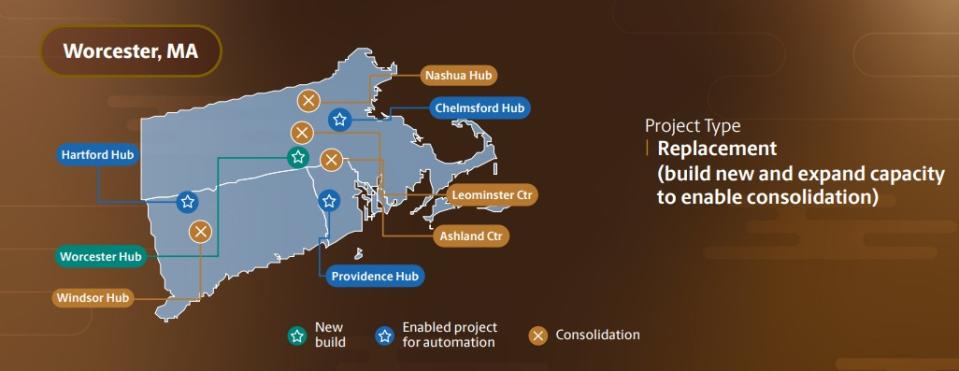UPS to close 200 sort centers in modernization push

UPS says a projected rebound in parcel demand combined with an aggressive strategy for network consolidation and automation to reduce excess capacity and labor costs will drive double-digit profit margins by 2026. Up to 200 facilities are slated for closure over a five-year period.
The optimization plan, code-named Network of the Future, is expected to save $3 billion per year by 2028 through better productivity, according to a new strategic framework outlined by management on Tuesday. The leadership team explained why it is targeting premium segments such as health care and small businesses, as well as nearshoring trends, as big opportunities.
The event for investors was held in a massive new aircraft hangar at the delivery giant’s global air hub in Louisville, Kentucky, and streamed on the web.
UPS (NYSE: UPS) declared financial targets for 2026 include revenue of $108 billion to $114 billion — up from $91 billion last year — an adjusted operating margin above 13%, free cash flow of about $17.5 billion and capital spending of about 5.5% of total revenue.
Wall Street, which wanted $3 billion in reduced costs by 2026 instead of 2028, didn’t seem impressed. The company previously warned that operating profit would be down 20% to 30% year over year in the first half and then rebound to be up by the same amount in the second half as the wage growth rate from the new Teamster contract eases. UPS’ share price fell 8% by Tuesday’s close, but recovered some ground on Wednesday.
The growth and productivity plan also will be boosted from the return of growth to the small package market, said Matt Guffey, chief commercial and strategy officer. The U.S. small package market was expected to grow from 74 million average daily packages to 108 million by 2023, but the COVID demand spike reverted, inflation increased and the industry only reached 84 million packages per day.
UPS estimates modest growth in 2024 to 88 million packages, rising to a daily volume of 98 million in two years, on a compound annual growth rate of 5.5%. International small package growth will be nearly flat this year but grow at a 3.5% annual rate to 30 million units in 2026.
Analysts said UPS’s revenue guidance for 11% growth in 2025 and 2026 is optimistic given average revenue growth of 5% to 10% in the 10 years prior to the pandemic and Amazon’s increasing capture of market share. They also questioned the need for mergers and acquisitions to reach the targets. BMO Capital Markets analyst Fadi Chamoun said UPS assumes it can make significant market share gains in premium market segments by leveraging its integrated network, which will be difficult to fully execute. He said a more realistic revenue target is $104 billion.
Also acting as a potential revenue drag is a capacity surplus equivalent to average daily volume of 12 million packages across the industry after e-commerce and delivery companies ramped up infrastructure to meet shelter-at-home demand during the pandemic. The company is doing its part to bring supply into equilibrium by closing 70 conventional sorting facilities in 2023 and 2024 and flowing more volume into automated facilities, said Nando Cesarone, president U.S. operations. By 2028, UPS will close 200 facilities and consolidate operations in high-capacity spaces.
The UPS forecast assumes that competitors such as Amazon,the U.S. Postal Service and regional parcel companies won’t add more capacity, said Ravi Shanker at Morgan Stanley. It should be noted, however, that Amazon has cut back on planned fulfillment centers and the USPS is streamlining its network too.
Warehouses outfitted with smart package technologies — such as autonomous guided vehicles, automated sorting systems, and systems that can prioritize processing for specific customer requirements without manual intervention — experience a 30% to 35% bump in effective handling capacity.
Atlanta-based UPS has 63 automation projects targeted between now and 2028 that will more than triple the number of buildings with automation to 400. In the U.S., the vast majority of the automation projects will be completed in existing buildings. Ten of those automation projects are new builds. Overall, UPS is investing $9 billion in network upgrades.
“Every single work area is being scrutinized for automation opportunities, not just our sortation hubs,” said Cesarone. Technologies being introduced include automated address correction and delivery redirection, automated dispatch for package car drivers and feeder operations, and affixing pre-load assist labels to packages. Automated loading and unloading of trailers is being pilot tested.
In Worcester, Massachusetts, UPS is replacing a facility built in 1969 with a larger one that will allow work from four regional facilities to be consolidated in one place, reduce network touches and improve utilization. Another example of network simplification is in Albany, New York, where the integrator is modernizing a facility to increase capacity, which will allow it to close another site.

In Harrisburg, Pennsylvania, UPS has closed 15 sort centers and reduced staffing, resulting in 60,000 fewer packages being physically handled per day. The less a parcel is dumped out, shuttled through a conveyor system and swept into bins, the less chance of damage. Together, area savings amount to $80 million.
UPS recently notified the state of Oregon it will close a package terminal in Portland and lay off 331 workers in mid-April because it wasn’t busy enough, according to the Portland Business Journal.
The Network of the Future bears similarities to FedEx’s network transformation called Network 2.0. FedEx, however, is delivering more tangible cost reductions in part because it needed greater changes to satisfy investor calls for better profitability. FedEx traditionally operated three distinct networks — Express, Ground and Freight — that weren’t very interoperable, and it has an airline more than twice the size of UPS’ fleet.
Target markets
UPS is much more than a parcel delivery company. On the logistics side, management said it aims for a 40% volume mix from small businesses and is building more digital tools to help them easily manage international shipments from end to end. And it plans to double revenue in health care logistics to $20 billion through organic growth and acquisitions by 2026.
Kate Gutmann, president of international, health care and supply chain solutions, said UPS is heavily investing in health care logistics, a market estimated to reach $152 billion in 2026 from $130 billion today, because an aging global population needs more drugs and biological medical products to deal with chronic disease.
“The health care logistics market is especially attractive to us, because it has year-round demand and is more resistant to economic downturns. That enables more predictability for operations across the whole supply chain. The majority of our health care customers buy more services across our end-to-end supply chain than customers in any other segment. That means we get a greater percentage of those customers’ total supply chain spend,” she added.
Pharmaceutical users account for 45% of UPS’ early morning delivery volume and are large users of premium services like Next Day Air and reverse logistics. The segment delivers operating margins in the high teens.

UPS and other third-party logistics providers are also benefiting from manufacturers diversifying their supply chains beyond China to Southeast Asia, India and Mexico. Gutmann said UPS is upgrading its physical and digital infrastructure to support new freight flows.
The express carrier, for example, is increasing throughput capacity in Asia to allow network and routing changes that will support growing demand and improve transit times. Last week it announced a significant expansion of its air terminal at Clark airport in the Philippines after adding nearly 237,000 square feet of cold-chain storage and distribution space there in 2023. Construction of the new Clark hub is set to begin next February, and the terminal will be fully operational in late 2026. In December, the company said it planned to build a new air cargo facility at Hong Kong International Airport by 2028 that is four times the size of the current hub and will be able to process 1 million tons per year.
Gutmann said UPS also plans to roll out this year an upgraded portal designed to improve efficiency of customs brokerage.
Click here for more FreightWaves/American Shipper stories by Eric Kulisch.
Twitter: @ericreports / LinkedIn: Eric Kulisch / ekulisch@freightwaves.com
RECOMMENDED READING:
FedEx deactivates 17 more aircraft as cost controls pay off
FedEx pilots take harder line as contract talks drag on
The post UPS to close 200 sort centers in modernization push appeared first on FreightWaves.
